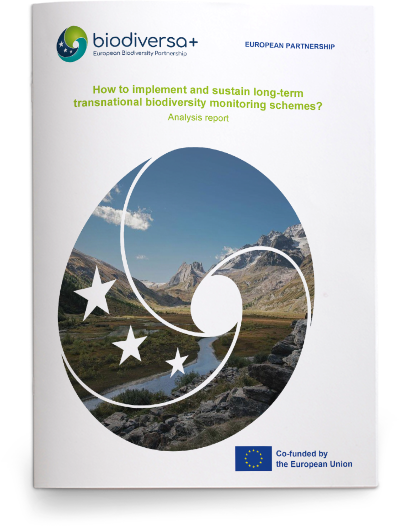“Analysis report on how to implement and sustain long-term biodiversity monitoring schemes”
Published: June 2025 | DOI: 10.5281/zenodo.15706165
Robust biodiversity monitoring is essential to track trends in nature, evaluate conservation efforts, and guide effective policy. Yet, implementing and sustaining monitoring across multiple countries presents unique challenges, from harmonising protocols to securing long-term funding. Drawing on case studies, expert workshops, and insights from Biodiversa+ pilots, this report provides guidance to build enduring, effective biodiversity monitoring networks.
Sustainability challenges
Establishing a pan-European network of sustainable biodiversity monitoring schemes hinges on two key challenges: transnational coordination and long-term support.
Transnational monitoring requires harmonised data collection across countries, robust data-sharing agreements, and coordinated workflows. It also demands careful planning for the storage and processing of both digital data and physical samples, with attention to infrastructure, legal, and environmental risks. Cross-border collaboration adds complexity, as partners must align objectives, agree on data ownership, and maintain consistent methods across diverse institutional and national contexts.
At the same time, ensuring long-term sustainability poses its own difficulties. While long-term data are vital for tracking ecological change and informing policy, sustained funding and institutional commitment are rare. Key obstacles include administrative burdens, data and sample storage over indefinite periods, reliance on specialised expertise, and adapting to evolving technologies. Resource limitations and a global shift towards short-term projects further threaten the continuity of these essential efforts.
Assessing sustainability
The report reviews five key aspects essential to the design and sustainability of long-term biodiversity monitoring schemes, comparing how each functions under top-down versus bottom-up governance models:
- Organisational structure: Examines how schemes are governed, who the key stakeholders are, and how responsibilities are distributed.
- Funding model: Looks at how monitoring efforts are financed, the stability of funding sources, and how financial responsibilities are managed.
- Coordination mechanisms: Focuses on how communication and collaboration are maintained across partners, including engagement strategies and onboarding processes for new members.
- Data management: Covers issues of data ownership, storage, access, and how data from different sources is integrated and used.
- Policy impacts: Assesses how schemes align with and inform policy, and the extent of their interaction with policy-makers.
This comparative analysis helps identify strengths and trade-offs in different governance models and supports the development of effective and scalable monitoring frameworks.
Governance models
The report identifies three governance models for biodiversity monitoring, each with distinct strengths and trade-offs:
- Top-down approaches are suited to mandated monitoring schemes aligned with international policy goals. They offer stable funding and ensure standardisation across countries but can be rigid and administratively complex. Their strength lies in delivering consistency and long-term support, especially when backed by legal commitments.
- Bottom-up approaches work well for initiatives driven by local actors, research institutions, or citizen scientists. They are cost-effective, adaptable, and foster strong engagement, but often struggle with funding stability and data harmonisation. These schemes excel when there is already a strong data foundation at national or regional level.
- Hybrid approaches aim to combine structure and flexibility. They align with policy objectives while allowing regional customisation and innovation. Hybrid models require careful coordination but are particularly well-suited to large-scale biodiversity monitoring where both top-down support and grassroots input are essential.
Ultimately, hybrid approaches offer a promising path for building resilient and scalable biodiversity monitoring networks across Europe.
Strategies for sustainability
The report outlines key strategies to support sustainable biodiversity monitoring schemes:
- Tailor governance to the data landscape: Where data exists but is fragmented, a bottom-up approach can help coordinate and harmonise efforts. In areas lacking data, a top-down model is needed to establish standards. A hybrid approach can combine both, adapting to regional differences while maintaining overall coherence.
- Secure stable and diversified funding: Long-term sustainability depends on embedding monitoring in policy frameworks for guaranteed support (top-down), developing cost-sharing or alternative funding mechanisms (bottom-up), or combining these approaches to ensure both core stability and flexibility for innovation (hybrid).
- Promote standardised, scalable methodologies: Ensuring methodological alignment is key. Established networks should prioritise harmonising data standards, while new ones must define clear metrics, such as Essential Biodiversity Variables, before expanding. Investing in emerging technologies can improve efficiency and comparability.
- Strengthen policy relevance: Monitoring schemes should align with EU conservation goals and deliver actionable insights. Bottom-up initiatives need to demonstrate credibility to be integrated into policy, while hybrid approaches can combine standardised frameworks with regional adaptation.
- Build long-term capacity and collaboration: Effective schemes depend on both technical training and engaged networks. Top-down efforts should offer structured capacity-building, bottom-up models should foster local expertise, and hybrid systems can support both through EU-level training and knowledge-sharing platforms.
To complement this read, check out the interview with Michele Bresadola, who led this work.
